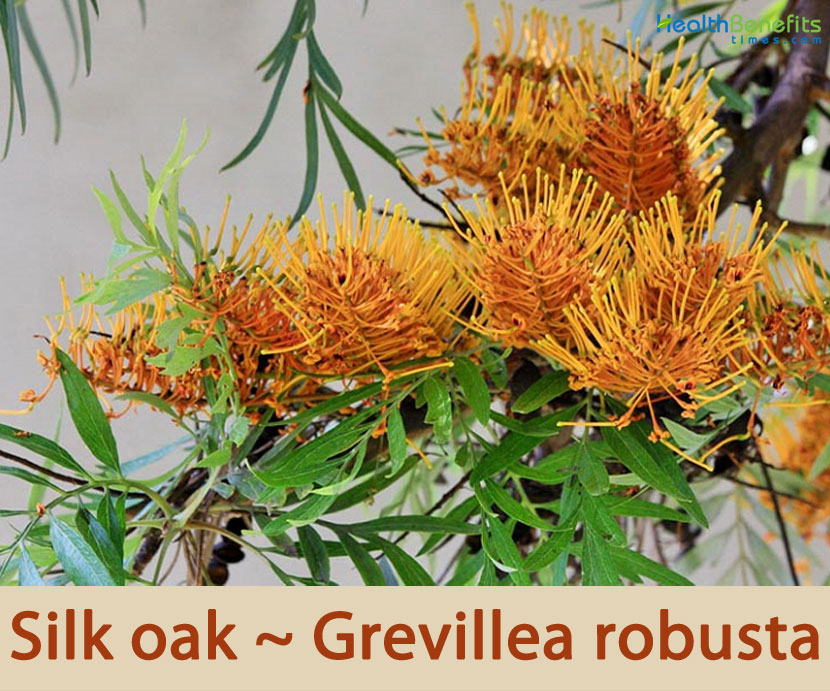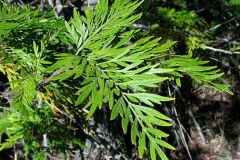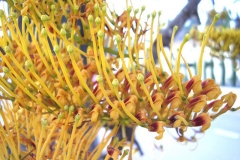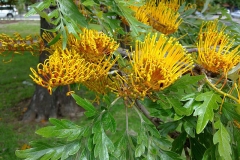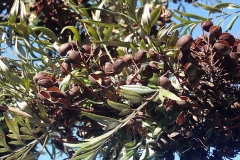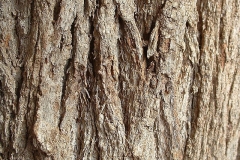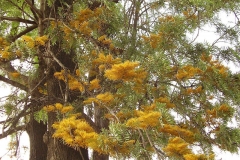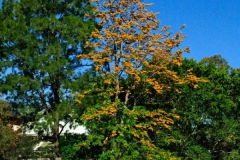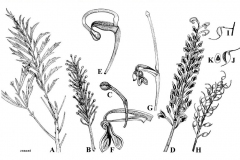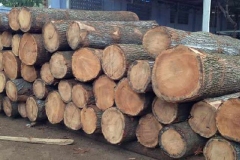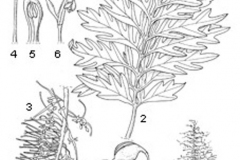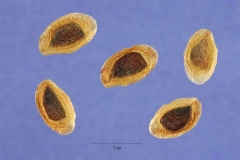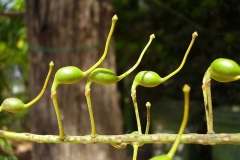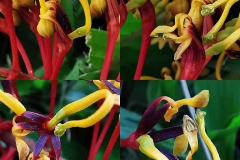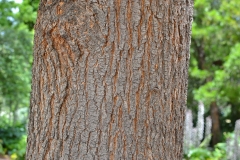| Silk oak Quick Facts | |
|---|---|
| Name: | Silk oak |
| Scientific Name: | Grevillea robusta |
| Origin | Coastal eastern Australia from the Clarence River, New South Wales, to Maryborough, Queensland |
| Colors | Initially green turning to dark brown to near black as they mature |
| Shapes | Small, flat, pod like, broad, slightly flattened (boat shaped) seedpods about 1.5-2.cm long, about 1 cm broad. |
| Health benefits | Beneficial for sore throats, earache, chest problems, flu, toothache, headaches and dizziness |
| Name | Silk oak |
|---|---|
| Scientific Name | Grevillea robusta |
| Native | Coastal eastern Australia from the Clarence River, New South Wales, to Maryborough, Queensland, and is now naturalized in Hawaii and southern Florida |
| Common Names | Australian silky-oak, he oak, she-oak, silk oak, silky oak, silver oak, southern silky-oak, Fernleaf, Golden pine, silk-oak grevillea, grevillea, river oak |
| Name in Other Languages | Afrikaans: Australiese selwereik, Silwereik Arabic: Bilut hariri (بلوط حريري) Assamese: Teli-wi Australia: River oak, silk oak Bengali: Raupasi (ৰূপসী) Brazil: Carvalho-sedoso, grevílea-gigante, grevilha-robusta Burmese: Khadaw hmi Chinese: Yín huà (银桦) Cuba: Roble plateado Danish: Bregnetræ, Bregnegrevillea Dominican Republic: Helecho Dutch: Australische zilvereik English: Australian silky-oak, Silk-oak, Silky oak, Silver oak, Southern silky-oak, silk-bark oak Finnish: Kultasilkkipuu French: Chêne d’Australie, grévillée robuste, grevillaire, fougère en arbre Germany: Silberstrauch, Australischer, australische Silbereiche, australischer Silberstrauch Hawaiian: Ha‘iku ke‘oke‘o, oka-kilika,haiku-keokeo Hebrew: גרווילאה חסונה Hindi: Silver oak Honduras: Gravilea Indonesia/Java: Salamander Italy: Grevillea Japanese: Shinobunoki (シノブノキ), Shirukīōku (シルキーオーク) Javanese: Salamandar Kannada: Silvar mara (ಸಿಲ್ವರ್ ಮರ) Kinyarwanda: Gereveliya Malayalam: Silvar ōkk (സിൽവർ ഓക്ക്) Manipuri: Koubilia (কৌবীলিযা) Ndebele: Kangiyo Nepali: Kangiyo (काँगियो) Persian: بلوط ابریشمی Portuguese: Grevilea, Grevilha, Grevílea-de-jardim, Grevílea-vermelha, Grevílea, carvalho-sedoso Puerto Rico: Roble de seda Russian: Grevilleya krupnaya (Гревиллея крупная) Spanish: Velika grevilka, Grevillea, pino rojo, roble australiano, roble de pelota, roble sedoso, pino australiano, agravilla, helecho , roble de seda Swahili: Mgrivea, mukima Swedish: Silvergrevillea Tamil: Malaic cavukku (மலைச் சவுக்கு), Chavukku (சவுக்கு) Maram (மரம்) Savukku-maram Tanzania: Mgrivea Thai: Son-india Tongan: ʻOke Ukrainian: Hrevileya mohutnya (Гревілея могутня) Urdu: Bekkar, bahekar USA: Lacewood USA/Hawaii: Haiku-keokeo, oka-kilika |
| Plant Growth Habit | Erect, fast-growing, single-stemmed, medium-sized to large evergreen tree |
| Growing Climates | Forest edges, coastal forests, disturbed sites, savannah and riparian areas, subtropical rainforest, dry rainforest and wet forests |
| Soil | Tolerant of a wide range of soils if they are well drained. It will grow on neutral to strongly acid soils but does best on those that are slightly acid |
| Plant Size | 35 m (114 ft.) in its natural habitat, though elsewhere it is more typically 15 to 25 m (50 to 80 ft.) tall. Bole is straight, branchless for up to 15 m, up to 80 (max. 120) cm in diameter |
| Crown | Crown is conical and symmetrical with major branches spaced at intervals of about 1 m |
| Bark | Bark on the trunk is dark grey and furrowed into a lace-like pattern. Inner bark reddish-brown |
| Branchlets | Young branchlets are angular and ridged, sub sericeous to tomentose but glabrous on older growth |
| Leaf | Alternate, fernlike, pinnately or almost bipinnately compound, 15-30 cm long and 9–15 cm wide, exstipulate with 11–31 primary lobes |
| Flowering season | September to November |
| Flower | Showy, yellowish, numerous, paired, on long slender stalks 1-2 cm, composed of 4 narrow yellow or orange sepals 12 mm long. Flower clusters are 7.5-15 cm long, unbranched, arising mostly from the trunk, in a terminal or axillary simple or branched raceme, protandrous |
| Fruit Shape & Size | Small, flat, pod like, broad, slightly flattened (boat shaped) seedpods about 1.5-2.cm long, about 1 cm broad |
| Fruit Color | Initially green turning to dark brown to near black as they mature |
| Seed | 1-1.5 cm long, 0.5-1 cm broad, broadly winged, thin, ovate, non-endospermic with a brown, ovate central seed body |
| Propagation | By seed and cuttings |
| Precautions |
|
Plant Description
Silk oak is an erect, fast-growing, single-stemmed, and medium-sized to large evergreen tree that normally grows about 35 m (114 ft.) in its natural habitat, though elsewhere it is more typically 15 to 25 m (50 to 80 ft.) tall. Bole is straight, branchless for up to 15 m, up to 80 (max. 120) cm in diameter, usually without buttresses. Crown is conical and symmetrical with major branches spaced at intervals of about 1 m. Bark on the trunk is dark grey and furrowed into a lace-like pattern. Inner bark is reddish-brown. Young branchlets are angular and ridged, sub sericeous to tomentose but glabrous on older growth.
The plant is found growing in forest edges, coastal forests, disturbed sites, savannah and riparian areas, subtropical rainforest, dry rainforest and wet forests. It adapts to various environmental conditions and is found between 500 and 2000m altitude where annual rainfall ranges from 800 to 1500mm. The plant is tolerant of a wide range of soils if they are well drained. It will grow on neutral to strongly acid soils but does best on those that are slightly acid.
Leaves
Leaves are alternate, fernlike, pinnately or almost bipinnately compound, 15-30 cm long and 9–15 cm wide, exstipulate with 11–31 primary lobes. Lobes are entire or divided, ultimate lobes 0.5–5 cm long and 0.2–1 cm wide. Upper surface is shiny dark green and hairless, while lower surface is silky with whitish or ash colored hairs with recurved margins. Petiole is 1.5–7 cm long. They remain on the tree where the dry season is short but fall where it is long or pronounced, leaving the branches mostly bare for a short period, just before flowering.
| Leaf arrangement | Alternate |
| Leaf type | Odd-pinnately compound; made up of 7-19 leaflets |
| Leaf margin | Parted, revolute |
| Leaf shape | Lanceolate |
| Leaf venation | Pinnate |
| Leaf type and persistence | Evergreen |
| Leaf blade length | 6 to 13 inches; leaflets are 1 to 4 inches |
| Leaf color | Green on top, silvery white underneath |
| Fall color | No color change |
| Fall characteristic | Not showy |
Flower
Flowers are showy, yellowish, numerous, paired, on long slender stalks 1-2 cm, composed of 4 narrow yellow or orange sepals 12 mm long. Flower clusters are 7.5-15 cm long, unbranched, arising mostly from the trunk, in a terminal or axillary simple or branched raceme, protandrous, petals 4, united into a tube that is mostly recurved under the broadened apex (limb); stamens 4, sessile in the concave limb; disk annular or semiannular, sometimes bilobed; ovary superior, 1-locular with 2 ovules, style curved and protruding from a slit in the perianth tube, the apex free from the limb, eventually straight, persistent. They bloom in perfusion from spring to early summer, with the most striking displays seen on near leafless trees.
| Flower color | Yellow orange |
| Flower characteristics | Showy; emerges on one side of a raceme |
| Flowering | Spring |
Fruit
Fertile flower are followed by small, flat, pod like, broad, slightly flattened (boat shaped) seedpods about 1.5-2.cm long, about 1 cm broad. They are initially green turning to dark brown to near black as they mature with long slender stalk and long, threadlike, curved style. Seeds 1-1.5 cm long, 0.5-1 cm broad, broadly winged, thin, ovate, non-endospermic with a brown, ovate central seed body.
| Fruit shape | Unknown |
| Fruit length | ½–¾ inch |
| Fruit covering | Dry or hard |
| Fruit color | Silvery gray to brown |
| Fruit characteristics | Does not attract wildlife; not showy; fruit/leaves a litter problem |
Traditional uses and benefits of Silk oak
- In Kenya, natives of the Kakamega Forest use the plant to treat sore throats, earache, chest problems, flu and toothache.
- In North Garo Hills, Meghalaya, NE India, bark and leaves used for headaches and dizziness.
Culinary Uses
- The flowers are one of the richest sources of nectar.
- This can be sucked directly from the flowers, shaken into a bowl or washed out in a small quantity of water.
- The nectar falls in showers when the flowers are shaken.
Other Facts
- The plant yields small quantities of a gum resin.
- Leaves consist of rutin, though quantities are not specified.
- Intense yellow and green dyes are obtained from the leaves.
- This tree is one of the most important re-afforestation trees in Nepal.
- It is sometimes used as a rootstock for the more susceptible species.
- Wood is used for paneling, joinery, cabinet making etc.
- It is considered a good fuel.
- The leaves are also used as mulch.
- It is very popular in agroforestry systems and often planted to provide shade for tea and coffee plantations.
- Trees usually begin to flower at about 10 years.
- There are reported to be 64,000 to 154,000 seeds per kilogram (29,000 to 70,000/lb.).
- It is regarded as a weed in parts of New South Wales and Victoria, as invasive in Hawaii and as an invader in South Africa.
- Silk oak timber was extensively used for external window joinery, as it is resistant to wood rot.
- It has been used in the manufacture of furniture, cabinetry, and fences.
- In the UK, Silk oak has gained the Royal Horticultural Society’s Award of Garden Merit.
- It is grown in plantations in South Africa, and can also be grown alongside maize in agroforestry systems.
- Wood is used in making railroad ties, plywood, air-freight cases and furniture, parquetry, turnery, boat building, interior trim, cabinet work, parquet flooring, boxes, toys and novelties.
- The golden flowers are attractive to bees, making it an important honey plant.
References:
https://www.itis.gov/servlet/SingleRpt/SingleRpt?search_topic=TSN&search_value=27783#null
http://www.hear.org/pier/species/grevillea_robusta.htm
https://pfaf.org/user/Plant.aspx?LatinName=Grevillea+robusta
https://www.cabi.org/isc/datasheet/25866
https://www.srs.fs.usda.gov/pubs/misc/ag_654/volume_2/grevillea/robusta.htm
https://plants.sc.egov.usda.gov/home/plantProfile?symbol=GRRO
https://edis.ifas.ufl.edu/publication/ST285
https://gd.eppo.int/taxon/GRERO
http://www.theplantlist.org/tpl/record/kew-2832700
https://indiabiodiversity.org/species/show/229827
https://en.wikipedia.org/wiki/Grevillea_robusta
https://www.iplantz.com/plant/791/grevillea-robusta/
http://apps.worldagroforestry.org/treedb2/AFTPDFS/Grevillea_robusta.PDF
http://www.flowersofindia.net/catalog/slides/Silver%20Oak.html


